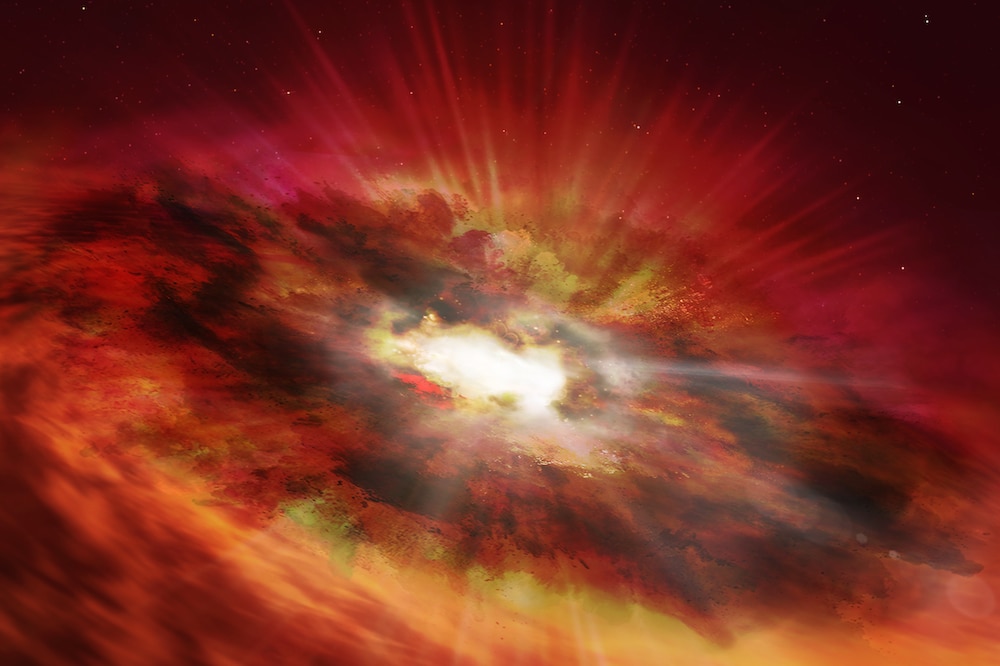Create a free profile to get unlimited access to exclusive videos, sweepstakes, and more!
Mashup of a galaxy and a quasar evolved into a supermassive black hole
Even monsters start out as embryos.

Space monsters that are all mouth lurk in the depths of every galaxy, but where did supermassive black holes emerge from, other than the particle accelerator in The Black Hole?
NASA’s Hubble Space telescope glimpsed something that could mean we’re starting to find out. GNz7q isn’t supermassive, but in its heart is a nascent and voraciously hungry black hole. This bizarre object could possibly explain how much larger beasts evolve. Supermassive black holes are believed to come into being as embryos in the cores of dusty starburst galaxies, eventually getting rid of all that dust and gas when they crawl out as quasars, ultraluminous active galactic nuclei (AGNs) so bright that they can easily outshine all the stars in a galaxy.
Until now, objects like GNz7q have only been hypothetical. They were predicted to exist but never actually found. Astronomer Seiji Fujimoto, of the Niels Bohr Institute of the University of Copenhagen, is now sure that GNz7q is somewhere between young galaxies and quasars. It was around 750 million years after the Big Bang during an epoch known as the Cosmic Dawn (when the first supermassive black hole spawned) and is what previous theories thought to be the progenitor of these huge black holes. Fujimoto led a study recently published in Nature.
“GNz7q shows unique aspects in several ways,” he told SYFY WIRE. “It is too bright as a galaxy, but too faint as a quasar from X-ray to optical, while it is very bright in far-infrared wavelengths that suggests very vigorously star-forming activities are taking place.”
Early supermassive black holes have been observed before, but how they form and evolve has remained a mystery. GNz7q, a compact ultraviolet object, is supposedly in a transitional phase, somewhere between a dusty galaxy and a blazing quasar. The black hole in its core is still growing, and the gas around it is not from galactic emissions, but proven to be the star stuff it was feeding on, swirling around in its accretion disc until it passed the event horizon. That gas was a dead giveaway. So was its extreme brightness in the UV part of the spectrum but faintness in shorter X-ray wavelengths. It had to be a proto-supermassive black hole.
This embryonic monster shows features of both a young galaxy and a quasar — just not enough to be either one. It might also not be the only object of its kind. Fujimoto expects more to be out there, because this one was hiding in plain sight. It was actually right in the middle of the part of the sky known as the Great Observatories Origins Deep Survey-North (GOODS-North), which has been scoured by Hubble and every powerful telescope you can possibly think of. Somehow, it was overlooked. After ruling out any alternate explanations, including the previous assumption that it was a lost dwarf star in the Milky Way, what it was finally shone through.
“The abundance of the ‘transition phase' corresponds to how often such a rapidly growing phase happens during the evolution of the super massive black hole,” said Fujimoto. “In other words, the evolution might not be completed with just one extreme period.”
Meaning, if there are many objects like GNz7q waiting to be found, it is possible that supermassive black holes may go through many phases of a dark metamorphosis, especially since there are some out there which are billions of solar masses. Now that the James Webb Space Telescope is squinting further out into the cosmos than Hubble, it might be able to find more transition-phase objects and also beam back data that tells researchers what the mass of the central black holes in those objects are, since that could reveal more about their evolution.
The James Webb Space Telescope should be able to observe the teenage black hole in GNz7q and beam back emission lines from the accretion disc of material being stuffed into its greedy mouth. That can then be used to find out the black hole’s mass, which can give insight into its evolution and how fast it is growing, or at least how fast it was growing billions of years ago, as we are seeing it from Earth.
“Webb is sensitive enough to detect near-infrared stellar emissions from the host galaxy, which is impossible with current facilities,” Fujimoto said. “Webb will decisively and quantitatively determine GNz7q’s young, rapidly growing black hole in the transition phase.”
This could be the time capsule that finally tells us how supermassive black holes are born.


























